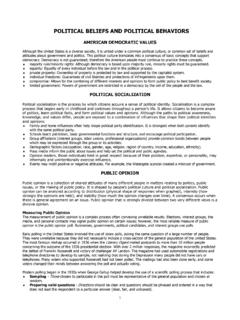Transcription of The Impact of the Industrial Revolution - Mr. Farshtey
1 The Impact of the Industrial Revolution The New Industrial Cities Industrialization brought about the rapid growth of towns and the development of megalopolises such as Greater London. The wealthy built fine homes, churches, and public buildings; the poor crowded into cheap, shoddy row houses Sudden population growth, crowding, and lack of municipal services made urban problems more serious than they had been in the past. Inadequate facilities for sewage disposal, air and water pollution, and diseases made urban life unhealthy and contributed to high infant mortality and short life expectancy Reports of the horrors of slum life led to municipal reforms that began to alleviate the ills of urban life after the mid-nineteenth century Rural Environments Almost all the land in Europe had been transformed by human activity before the Industrial Revolution , but deforestation was an ongoing problem.
2 Americans transformed their environment even faster than Europeans, clearing land, using it until the soil was depleted, and then moving on Industrialization relieved pressure on the English environment in some ways;. agricultural raw materials were replaced by Industrial materials or by imports, while the use of coke and the availability of cheap iron reduced the demand for wood New transportation systems greatly changed rural life. Toll roads, canals, and then railroads linked isolated districts to the great centers of commerce, industry, and population Working Conditions Industrialization offered new, highly- paid opportunities for a small number of skilled carpenters, metalworkers, and machinists; but most Industrial jobs were unskilled, repetitive, boring, badly paid, and came with poor working conditions The separation of work from home had a major Impact on women and on family life Women workers were concentrated in the textile mills and earned much less than men.
3 Husbands and wives worked in separate places. Most of the female work force consisted of young women who took low-paid jobs as domestic servants Poverty and employers' preference for child workers led to high rates of child labor. In the mid-nineteenth century the British government restricted child labor, so mill owners recruited Irish immigrants instead In America, the first industrialists offered good wages and decent working conditions to their women workers, but harsh working conditions, long hours and low pay soon became standard. Protests by American women workers led factory owners to replace them with Irish women, who were willing to accept lower pay and worse conditions The Industrial Revolution increased the demand for cotton, sugar, and coffee.
4 In doing so, industrialization helped to prolong slavery in the United States and the Caribbean and to extend slavery to the coffee-growing regions of Brazil Changes in Society Industrialization increased disparities in income. The wages and standards of living of the workers varied with the fluctuations of the business cycle, but overall, workers' standards of living did not improve until the 1850s The real beneficiaries of the Industrial Revolution were the middle classes. Rising incomes allowed the middle class to build their own businesses, to keep their women at home, and to develop a moral code that stood in contrast to the squalor and drunkenness of the working class New Technologies and the World Economy Railroads By 1850 the first railroads had proved so successful that every industrializing country began to build railroad lines.
5 Railroad building in Britain, France, Germany, Canada, Russia, Japan, and especially in the United States fueled a tremendous expansion in the world's rail networks from 1850 to 1900. In the non-industrialized world, railroads were also built wherever they would be of value to business or to government Railroads consumed huge amounts of land and timber for ties and bridges. Throughout the world, railroads opened new land to agriculture, mining, and other human exploitation of natural resources. Steamships and Telegraph Cables In the mid-nineteenth century a number of technological developments in shipbuilding made it possible to increase the average size and speed of ocean-going vessels. These developments included the use of iron (and then steel) for hulls, propellers, and more efficient engines Entrepreneurs developed a form of organization known as the shipping line in order to make the most efficient use of these large and expensive new ships.
6 Shipping lines also used the growing system of submarine telegraph cables in order to coordinate the movements of their ships around the globe. Electricity In the 1870s inventors devised efficient generators that turned mechanical energy into electricity that could be used to power arc lamps, incandescent lamps, streetcars, subways, and electric motors for industry Electricity helped to alleviate the urban pollution caused by horse-drawn vehicles. Electricity also created a huge demand for copper, bringing Chile, Montana, and southern Africa more deeply into the world economy. World Trade and Finance Between 1850 and 1913 world trade expanded tenfold, while the cost of freight dropped between 50 and 95. percent so that even cheap and heavy products such as agricultural products, raw materials, and machinery were shipped around the world The growth of trade and close connections between the Industrial economies of Western Europe and North America brought greater prosperity to these areas, but it also made them more vulnerable to swings in the business cycle.
7 One of the main causes of this growing interdependence was the financial power of Great Britain. Non- Industrial areas were also tied to the world economy. The non- Industrial areas were even more vulnerable to swings in the business cycle because they depended on the export of raw materials that could often be replaced by synthetics or for which the Industrial nations could develop new sources of supply. Nevertheless, until World War I, the value of exports from the tropical countries generally remained high, and the size of their populations remained moderate Social Changes Population and Migrations Between 1850 and 1914 Europe saw very rapid population growth Emigration from Europe spurred population growth in the United States, Canada, Australia, New Zealand, and Argentina.
8 As a result, the proportion of people of European ancestry in the world's population rose from one-fifth to one- third. Reasons for the increase in European population include: 1. A drop in the death rate 2. Improved crop yields 3. The provision of grain from newly opened agricultural land in North America 4. And the provision of a more abundant year-round diet as a result of canning and refrigeration Asians also migrated in large numbers during this period, often as indentured laborers Urbanization and Urban Environments In the latter half of the nineteenth century European, North American, and Japanese cities grew tremendously both in terms of population and of size. In areas like the English Midlands, the German Ruhr, and around Tokyo Bay, towns fused into one another, creating new cities.
9 Urban growth was accompanied by changes in the character of urban life. Technologies that changed the quality of urban life for the rich (and later for the working class as well) included: 1. Mass transportation networks 2. Sewage and water supply systems 3. Gas and electric lighting 4. Police and fire departments 5. Sanitation and garbage removal 6. Building and health inspection, schools, parks, and other amenities. While urban environments improved in many ways, air quality worsened. Coal used as fuel polluted the air, while the waste of the thousands of horses that pulled carts and carriages lay stinking in the streets until horses were replaced by streetcars and automobiles in the early twentieth century.
10 Middle-Class Women's Separate Sphere . The term Victorian Age refers not only to the reign of Queen Victoria ( . 1901), but also to the rules of behavior and the ideology surrounding the family and relations between men and women. Men and women were thought to belong in separate spheres, the men in the workplace, the women in the home. Before electrical appliances, a middle- class home demanded lots of work The advent of modern technology in the nineteenth century eliminated some tasks and made others easier But rising standards of cleanliness meant that technological advances did not translate into a decrease in the housewife's total workload. The most important duty of middle- class women was to raise their children.




![Europe in the Postclassical Era.ppt [Read-Only]](/cache/preview/3/f/0/5/a/f/4/a/thumb-3f05af4abb01b691e0d84337014c46bf.jpg)




